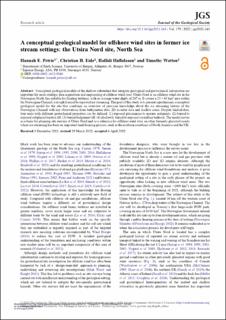A conceptual geological model for offshore wind sites in former ice stream settings: The Utsira Nord site, North Sea
Journal article, Peer reviewed
Published version

Åpne
Permanent lenke
https://hdl.handle.net/11250/3009965Utgivelsesdato
2022Metadata
Vis full innførselSamlinger
- Department of Earth Science [1050]
- Registrations from Cristin [9791]
Sammendrag
Conceptual geological models of the shallow subsurface that integrate geological and geotechnical information are important for more strategic data acquisition and engineering at offshore wind sites. Utsira Nord is an offshore wind site in the Norwegian North Sea suitable for floating turbines, with an average water depth of 267 m. It covers a 23 km x 43 km area within the Norwegian Channel, a trough formed by repeated ice streaming. The goal of this study is to present a preliminary conceptual geological model for the site, which combines an overview of previous knowledge about the ice streaming history of the Norwegian Channel with key observations from bathymetric data, 2D acoustic data, and shallow cores. Despite limited data, four units with different geotechnical properties can be defined: 1) exposed glacimarine to marine sediments, 2) buried to exposed subglacial traction till, 3) buried lodgement till and 4) shallowly buried to exposed crystalline bedrock. The model serves as a basis for planning site surveys at Utsira Nord and as a reference for offshore wind sites on other formerly glaciated coasts where ice streaming has been an important land-forming process, such as the northern coastlines of North America and the United Kingdom.
